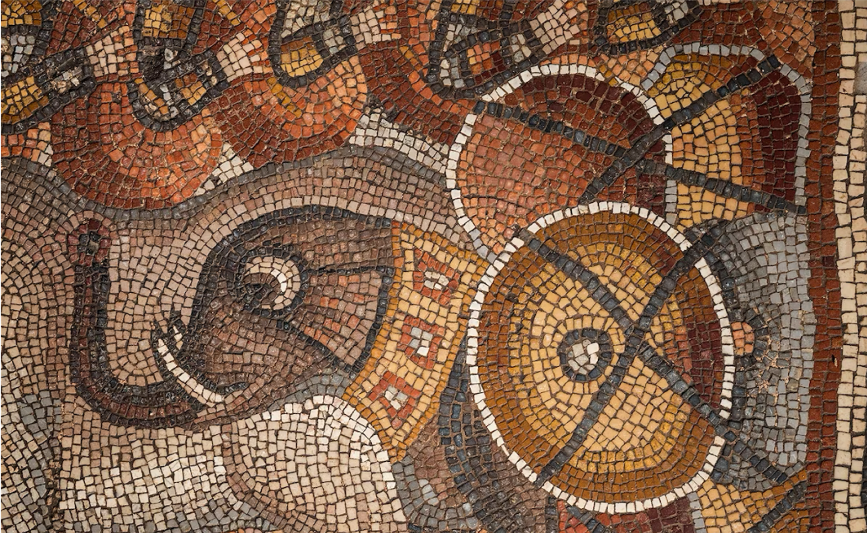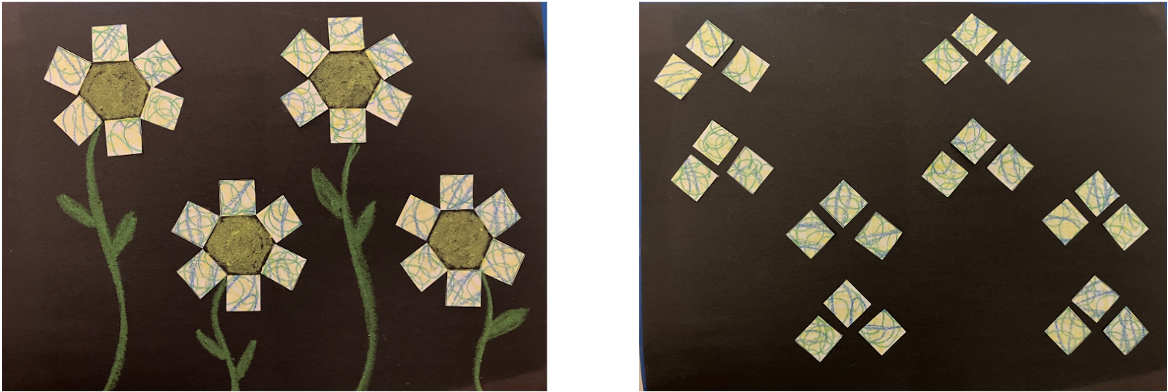POLYGON PERSPECTIVES – MATH MEETS CREATIVITY | BRINGING GEOMETRY TO LIFE THROUGH SCULPTURE 5
POLYGON PERSPECTIVES–MATH MEETS CREATIVITY:BRINGING GEOMETRY TO LIFE THROUGH SCULPTURE
Learning Description
In this lesson, students will work collaboratively using the Engineering Design Process to create a sculpture inspired by the artist, Alexander Calder, that demonstrates their understanding of the properties and defining attributes of various polygons.
Learning Targets
"I Can" Statements
“I Can…”
- I can create a sculpture inspired by the artist, Alexander Calder, that demonstrates my understanding of the properties and defining attributes of various polygons.
- I can collaborate with others using the Engineering Design Process to create a sculpture.
Essential Questions
- What are the properties and defining attributes of various polygons?
- How can I demonstrate my understanding of the properties of polygons through sculpture?
Georgia Standards
Curriculum Standards
5.GSR.8.1 Classify, compare, and contrast polygons based on properties.
5.GSR.8.2 Determine, through exploration and investigation, that attributes belonging to a category of two-dimensional figures also belong to all subcategories of that category.
Arts Standards
VA5.CR.1 Engage in the creative process to generate and visualize ideas by using subject matter and symbols to communicate meaning.
VA5.CR.2 Create works of art based on selected themes.
VA5.CR.4 Understand and apply media, techniques, processes, and concepts of three-dimensional works of art.
VA5.RE.1 Use a variety of approaches for art criticism and to critique personal works of art and the artwork of others to enhance visual literacy.
South Carolina Standards
Curriculum Standards
5.G.3 Understand that attributes belonging to a category of two-dimensional figures also belong to all subcategories of that category.
5.G.4 Classify two-dimensional figures in a hierarchy based on their attributes.
Arts Standards
Anchor Standard 1: I can use the elements and principles of art to create artwork.
Anchor Standard 2: I can use different materials, techniques, and processes to make art.
Anchor Standard 5: I can interpret and evaluate the meaning of an artwork.
Key Vocabulary
Content Vocabulary
- Polygon - A plane figure enclosed by line segments called sides
- Regular polygon – A polygon whose sides are all equal and whose interior angles are all congruent
- Parallel lines - Lines in the same plane that never intersect, no matter how far they are extended
- Perpendicular lines - Lines that intersect at a 90-degree angle, forming right angles where they meet
- Triangle – A polygon with three sides and three angles
- Equilateral triangle – A triangle with three equal sides and three congruent triangles
- Isosceles triangle – A triangle with two equal sides and two congruent angles
- Scalene triangle – A triangle with three different sides and three incongruent angles
- Right triangle – A triangle in which one angle is a right angle
- Acute triangle – A triangle with three acute (less than ninety degrees) angles
- Obtuse triangle – A triangle with one obtuse (greater than ninety degrees) angle
- Quadrilateral – A polygon with four sides
- Trapezoid – A quadrilateral with only one set of parallel sides
- Isosceles trapezoid – A trapezoid whose non-parallel sides are equal in length
- Rectangle – A quadrilateral with four right angles
- Square – A quadrilateral with four right angles and four equal sides
- Parallelogram – A four-sided plane rectilinear figure with opposite sides parallel.
- Rhombus - A parallelogram with opposite equal acute angles, opposite equal obtuse angles, and four equal sides
- Pentagon – A five-sided polygon
- Hexagon – A six-sided polygon
- Octagon – An eight-sided polygon
Arts Vocabulary
- Sculpture - A three-dimensional work of art that can be made from a variety of materials, such as wood, clay, metal, or stone.
- Stabile - Large-scale sculptures that are abstract; they are made of large two-dimensional shapes put together to make a three-dimensional form; created by the artist Alexander Calder
- Mobile - Sculptures that are designed to move and change form through balance and interaction with air currents; created by the artist Alexander Calder
- Shape - Refers to an interesting and interrelated arrangement of body parts of one dancer; the visual makeup or molding of the body parts of a singular dancer; the overall visible appearance of a group of dancers (they may be curved/angular, symmetrical/asymmetrical, positive/negative)
- Warm colors - Yellow, orange, red (and shades of each)
- Cool colors - Purple/violet, blue, green (and shades of each)
- Complementary colors - Colors that are across from each other on the color wheel (such as orange and blue)
- Analogous colors - Colors next to each other on the color wheel
- Neutral colors - Brown, tan, white, black, gray, etc.
Materials
- Image of Alexander Calder’s sculpture, “Small City”
- 10x2 artful thinking routine
- Digital image of the Engineering Design Process (in lesson)
- Digital image of a color wheel
- Styrofoam (such as styrofoam plates) or thin cardboard, like chipboard (or cereal boxes that have been deconstructed so that they are flat)
- Scissors
- Rulers/straightedge
- Pencils
- Paper
- Optional–Oil pastels (for brown cardboard or styrofoam) OR markers/colored pencils/crayons/oil pastels for white cardboard
- Optional–Newsprint or butcher paper to protect desks/tables
Instructional Design
Opening/Activating Strategy
- Show students an image of Alexander Calder’s sculpture, “Small City”, 1964.
- Ask students to engage in the 10x2 artful thinking routine.
- Students should identify ten things that they see in the image.
- Students should then look at the image again and find ten additional things that they see.
- Students’ observations can be focused on lines, shapes, colors, angles, etc.
- After students have identified twenty things that they see, have them discuss with a partner or small group to compare findings.
- Allow time for groups to share one or two things that they noticed.
- Direct the conversation towards the geometric aspects of Calder’s sculpture.
- Tell students that Calder was known for two types of sculptures, Mobiles and Stabiles.
- Stabiles are large-scale sculptures that are abstract; they are made of large two-dimensional shapes put together to make a three-dimensional form.
- Mobiles are sculptures that are designed to move and change form through balance and interaction with air currents.
- Tell students that “Small City” is an example of a combination of the two types of sculpture.
Ask students to reflect on how they think the artist made the sculpture and what they think he had to consider when designing it.
Work Session
- Show students an image of the Engineering Design Process.

- Tell students that they will use the process in their lesson today.
- Divide students into pairs or small groups of three.
- Students should write down the question: How can I demonstrate the properties and defining attributes of polygons through a Stabile sculpture?
- Ask students to brainstorm what other questions they need answers to.
- Examples: What are the properties of polygons? How many types of polygons should I show? What materials can I use?
- Imagine:
- Show students a list of all materials available to them: Styrofoam (such as plates) or thin cardboard, like chipboard (or cereal boxes that have been deconstructed so that they are flat), scissors, rulers, pencils, and oil pastels.
- Ask students to brainstorm how they could use these materials to answer the question.
- Next, provide students with constraints and criteria for their sculpture. This will be determined by the teacher.
- Ideas include:
- Your sculpture must be free-standing.
- Your sculpture must have three different types of polygons.
- You must have at least five polygons in your sculpture.
- You must show an example of parallel lines and an example of perpendicular lines.
- You must use color in a meaningful way in your sculpture (i.e. All triangles are one color, all quadrilaterals are another color, etc. OR your sculpture follows a color scheme such as warm colors or cool colors).
- Your sculpture must be at least ________ big but can be no smaller than ______.
- Next, students should plan their sculptures by drawing a sketch and labeling their materials.
- Ideas include:
- Ask students to brainstorm what other questions they need answers to.
If needed, show students an example of Stabile Sculpture that demonstrates geometric concepts (see below).

- If students are adding color, show them an image of a color wheel and discuss the different types of color schemes that are common in art: Warm, cool, complementary, analogous, and neutral.
- Students should then label the colors they will use on their sketch.
- Once students have planned, they should show their plans to another group for feedback. The group providing feedback should comment on whether the sculpture met the criteria and whether they have questions about the construction of the sculpture/its stability, etc.
- Students can then begin to create their sculptures using the materials provided.
- Students should use their rulers to draw their polygons on the cardboard or styrofoam prior to cutting them out.
- Optional: Students can add color to their polygons. Remind students that because they are making a sculpture, they need to add color to both the front and the back of each polygon.
- Students will need to problem-solve how to attach the individual polygons together so that it becomes a three-dimensional sculpture.
- This can be done by cutting a notch in each polygon and sliding them together. However, allowing students to come to the solution through trial and error is beneficial.
- Students should complete a written explanation of what polygons they showed and where they showed them. This can be done on a 3 x 5 card as a list or on a checklist.
- After the sculptures are complete, have students display their planning sketch next to the completed sculpture. Students can do a gallery walk observing the different ways that students answered the original question.
Closing Reflection
- Conclude the lesson by having students reflect on their process with the following questions. This can be done in STEAM journals or through small group or large group discussion.
- If you could create your sculpture again, what would you do differently?
- What challenges did you face when turning your plan for your sculpture into the actual sculpture? How did you overcome those challenges?
- How did you use sculpture to demonstrate the properties and defining attributes of various polygons?
Assessments
Formative
- Students’ ability to identify geometric concepts in “Small City”
- Students’ brainstorming and planning phases for their sculptures
Summative
- Students’ sculptures should demonstrate that students understand and can demonstrate the properties and defining attributes of polygons.
- Students’ sculptures should demonstrate that they understand that Stabiles are created by combining two-dimensional geometric shapes together to create a three-dimensional form.
- If color is used, sculptures should demonstrate that students meaningfully used color in their artwork.
DIFFERENTIATION
|
Acceleration: Instead of providing criteria to students, have them establish their own criteria based on the design challenge and the standard. Remediation:
|
CREDITS
U.S. Department of Education- STEM + the Art of Integrated Learning
Ideas contributed by: Katy Betts
*This integrated lesson provides differentiated ideas and activities for educators that are aligned to a sampling of standards. Standards referenced at the time of publishing may differ based on each state’s adoption of new standards.
Revised and copyright: June 2025 @ ArtsNOW



